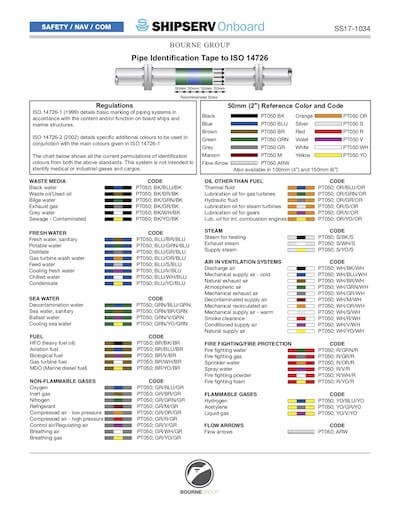
The International Organization for Standardization (ISO) has specified the colors that are used to identify piping systems within marine structures and on ships. These color standards can be used for land installations as well as piping systems that are drawn out or diagramed. However, ISO 14726 does not apply to piping systems that contain medical gases, industrial gases, or cargo.
There are two different colors used for each pipe on a marine vessel. The main color identifies the group of the substance and what it is used for. This is on either side of the secondary color. That secondary color in the middle identifies what the substance actually is. There are a multitude of combinations in ISO 14726 for this type of identification system which means it can be difficult to memorize all of them. For this reason, there is usually a posted chart in facilities that use this sort of pipe marking to provide reference for workers.
The main colors used in ISO 14726 are as follows:
- Black - Waste media
- Blue - Fresh water
- Brown - Fuel
- Green – Sea water
- Grey - Non-flammable gases
- Maroon - Air and sounding pipes
- Orange - Oils other than fuels
- Silver - Steam
- Red - Fire fighting
- Violet - Acids, alkalis
- White - Air in ventilation systems
- Yellow - Flammable gases
The secondary colors are the same as above, but the identification of the pipe’s contents depends on what main color is used in conjunction with the secondary color. For example, the main color can be black for waste media and if the secondary color is blue then the contents of the pipe are identified as black water, but if the secondary color is brown then the contents are identified as waste oil. It’s still in the category of waste, but it’s a different kind of waste that may require a different handling procedure.
The regulation also contains the recommended size that each color bar should be which is 50mm (2 in) wide. This also includes the directional arrow bar that indicates the flow direction of the pipe contents. However, there are also 100mm (4 in) and 150mm (6 in) sizes in case the pipe is so large that it needs a bigger label for better visibility.
Similar Glossary Terms
- International Standards Organizations (ISO)
- IIAR
- ISO 22000
- Wire Colors
- ANSI Safety Colors
- Line Labeling
- Anhydrous Ammonia Refrigeration
- Leak Detection
- NOM-26



